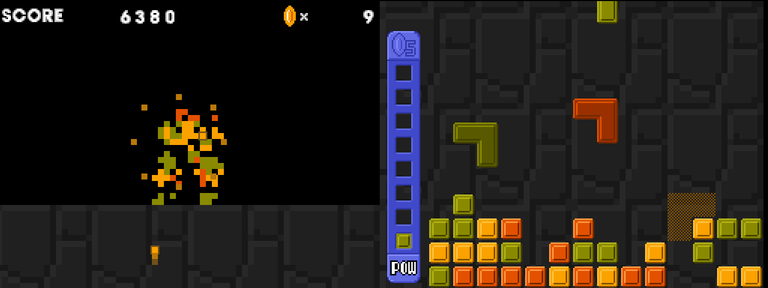

If you thought Picross 3D was an obscure puzzler, then you haven't seen this DSi-exclusive puzzle game.
...Of course you haven't. That's why I'm here to tell you about it.
This was one of many DSiware titles released for the titular Nintendo DSi, which sacrificed the GBA slot for an integrated main menu with a virtual shop for smaller games to buy digitally, and this game I actually owned as a kid because of the free points you got at the start, somehow saw that one game and bought it.
And you know you can take my word on that beig a real story as the last time I had my DSi was over ten years ago...as I lost it before I even got my 3DS. By that time when the console was still fresh, it had zero exploits or homebrew - those coming only by the time the 3DS was also cracked open. Even most flashcards could be rendered useless with a DSi console if a certain update targeted them.
But enough backstory, time to talk about the actual game. It has been quite a few years it took for DSi games to be emulated, and thus, allow me to revisit this game after so long.
What is a PiCTOBiTS and how do you play it?
So, you have these blocks at the bottom, a grid of sorts to your left that shows what colors you have stored, and blocks will fall from the top.
If you tap or hold over the blocks you have, you store them. If you tap or hold over empty areas of the screen, you place them.
The idea looks simple: You place colored blocks so that the falling pieces, which look like whole pieces instead of separate blocks, line up with any you've placed and form either a 4+ tall column, a 4+ wide row, or a 2x2 or bigger square.

And you can get creative in what solutions you can do, as sometimes it is optimal if not clearly intended for you to do a shape that acts like a half where the falling piece can neatly fit into.
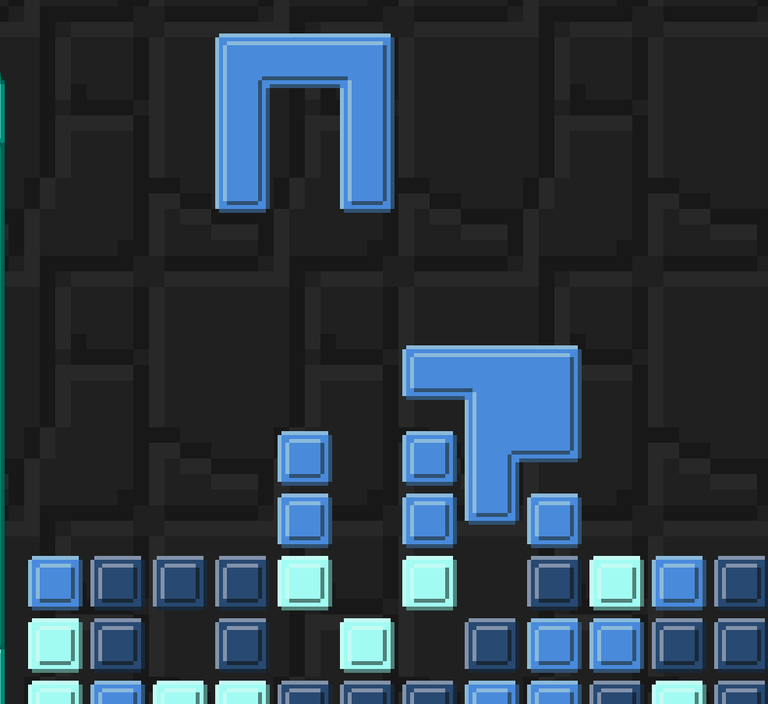
Take note of how the blocks falling will pause when you do a chain, but any block patterns that are in the middle of a chain or you tap yourself will keep falling at a fast pace.
All of this is also explained in the included tutorial, so at least this puzzle game does give you the option to learn what do you even do here if you play it for the first time.
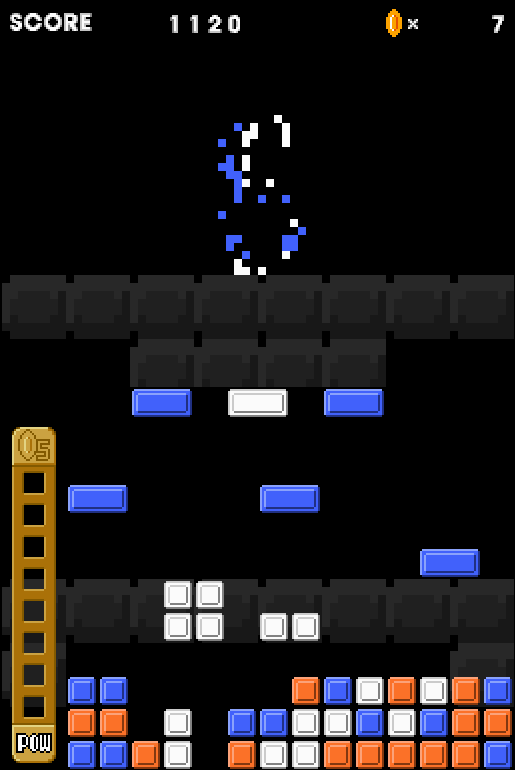
But like any good puzzle game, the devil is in the details.
See, while at first you'll see simple patterns for you to setup blocks and chains, the game will soon throw blocks with multiple colors that force you to think how to piece apart each color to be able to clear all cleanly, or at most, the colors that you need the most or are the biggest targets to catch. More on this later.
Oh, and here's a bit I NEVER knew of before from this game until I had read another review: The POW block at the corner?
If you tap it, it will erase the first two rows you have at the ground and pull everything else to the ground with gravity [including floating blocks]...but you'll forfeit one of your palette slots.
You can press the button at the top of the palette to restore a slot though - at the cost of five coins. And it will only let you use the coins you get from playing the stage itself [while at the same time, this will obviously reduce the coins you keep at the end if you complete the stage].
I always played with all slots and rushing to take any floating blocks down to earth manually as soon as possible because I didn't know that 😅 - although I also found out that the way you get stars for levels is if you complete it WITHOUT using the POW block.
No wonder I always got those even when I struggled to complete the stages in the first place 😅
A musical goal
A thing that really adds to this game is that, despite the minimal looking presentation on the surface, the sounds when you pick up and place blocks are in tune with the music of the current stage you're playing, which in itself will start in a minimal form until it starts sounding more like the original...and then starts sounding even more packed than the original when you are almost done.
This ties to how the goal of the game is to clear enough pieces of a certain color to fill out a sprite at the top of the screen, which is tied to a specific game - hence the specific music choices.

If you fill out a certain color on the sprite to the maximum, you'll notice with how any clears you do of said color will have a muted sound and visual effect, instead of the normally noticeable effect, which tells you without words which colors you are already done with.
Wait, this is harder than I remember
This game gets TOUGH not too long after the first levels, as it will push you to actually use that aforementioned [picking apart patterns] skill that might seem like overkill at first...until you see stuff like these.
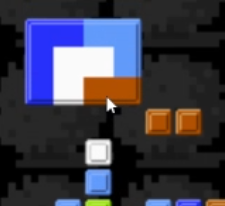
And this DOES have a solution...but if you don't get used fast to the game and its logic, then these will be quite the curveballs.
This is already partially solved in the screenshot: Two brown blocks to the side to make a row, one white block where the big piece should land on with the brown blocks cleared, then a cyan block below that where it also lands after the white blocks are cleared, and then, while I didn't put them here, you can place two blue blocks to the side of those so that the blue blocks also get cleared at the same time the cyan one does - as the brown and white blocks are cleared by that point.
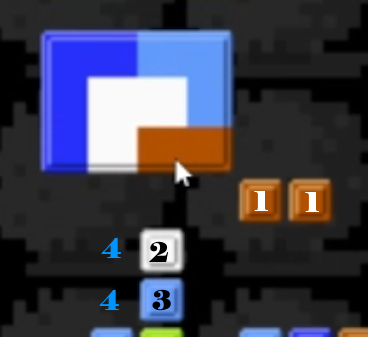
...Although I instead was a bit lazier and placed a single bit below the blue column so that at least was cleared - I ended with a stray blue block...but unless they are Permabits [I'll mention them soon] or you are too full on the field, there's no harm with having little stray blocks fall.
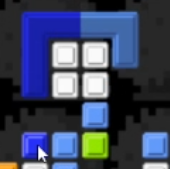
In fact, sometimes you may need to leave pieces fall intentionally without clearing them if they have any colors you ran out of - especially if it is the color you happen to need the most of right now.
While the game only has 15 normal stages, the example above is from Stage 11, so you know that it almost literally starts asking you to double think your plays halfway through.
Additionally, you'll eventually see these crossed out blocks by Stage 12, the Permabits, which if they fall into your field...they CANNOT be picked up ever. The only way to get rid of those is if you happen to use them on a chain to clear a falling piece [which is only doable by luck and setting up fast if you see a chance to do it]...or by clearing them BEFORE they land.

So you better catch those fast. Especially if you don't want them to land near the top and end your run.
That is just an example of a complex pattern, but then this ramps up with a faster pace for blocks dropping by the time you are getting to Stage 9, getting to a critical point in Stage 14.
Behold.
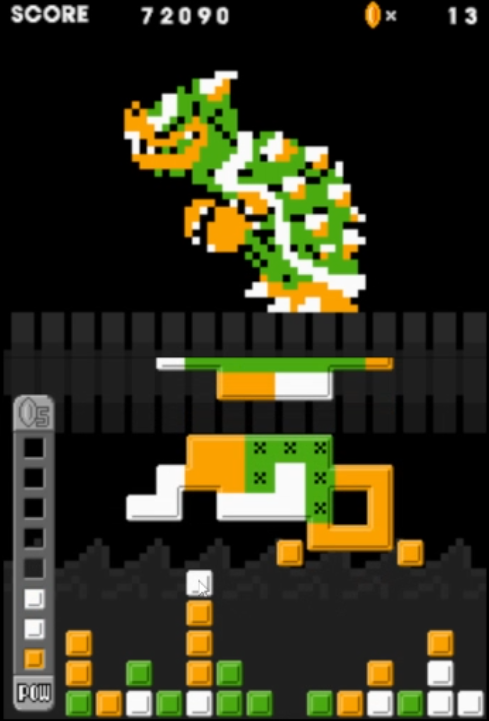
Not only quite the complex patterns you have to read and remember the solutions on how to piece them apart [if you have figured them out yet - if you don't...oh boy], but also you have to put those solutions FAST due to the pace they drop with little pause. This stage took me almost 30 minutes to complete, not just due to how I was playing with a mouse instead of the intended touch screen on real hardware, but also with how sometimes it can short-fuse your attention when it asks you to setup blocks for a single pattern...and then drops two more as you are trying to deal with that one.
I eventually survived, and got to Stage 15 which is harder in some ways and yet easier in others than Stage 14.
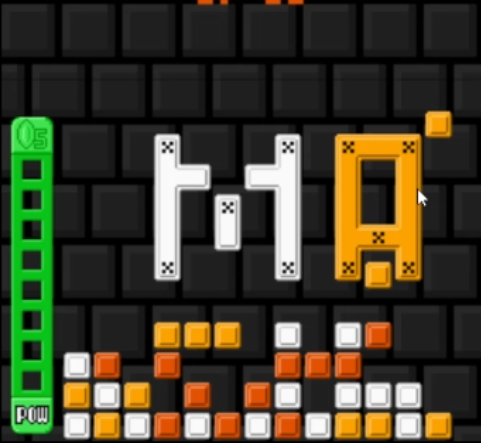
The blocks do NOT stop falling at all unless you do chains and the patterns are literally "THANK YOU MARIO! BUT" before the usual break for you to chain easy columns until the pattern restarts...but because the pattern is always the same, you can learn to strategize and setup in advance against this pattern, which is easier to do when you notice how you can aim for the permabits with a few strategically placed blocks in each letter.
And my prize was one of my favorite credit tunes of all games - one that's buried in this pretty obscure game by this point but uses the title screen motif in a much more happy tune while mixing in the leitmotifs of the NES titles represented, ending with the Super Mario Bros's level finish and a very satisfying finale.
What do you mean there's more?
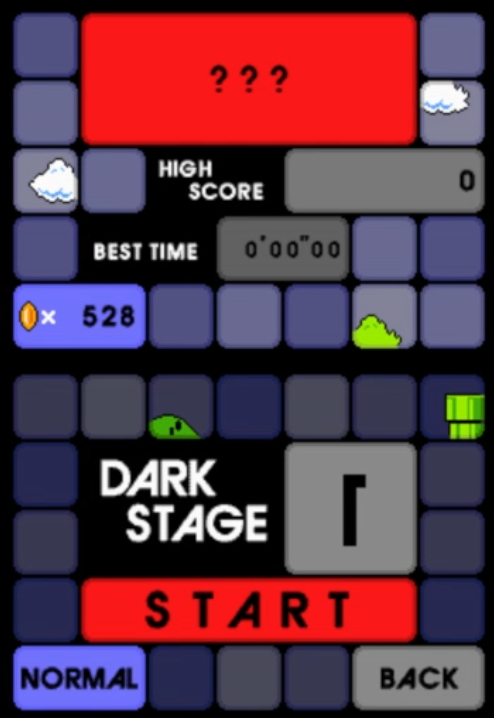
...Yeah.
This game has 15 NORMAL stages, but if you play and get coins, you may notice how there's a button at the corner in the stage select to...buy something?
And when you do...
Let me tell you, these are NOT messing around. If you want to know how bad these could be, this is a screenshot from the first Dark stage, the only one I've tried so far.
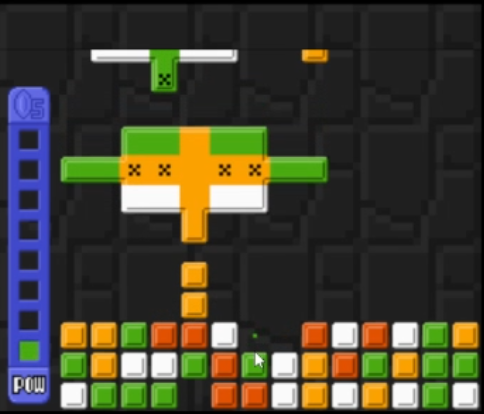
The funniest part is how the later Dark stages cost quite a penny to buy, but the very first one only costs 20 coins, so anyone could potentially buy it from curiosity and get destroyed by stuff that you would normally only see in Stage 10 onwards. And from what I've heard, the later Dark stages are somehow even worse.
But I won't talk about those because, again, I only tried the first one as of writing this.
Conclusion
This is a game that has been BURIED with time because of the extremely specific platform it was made for and the passage of time: A DSiWare exclusive title that, while quite acclaimed on its day and even made the jump to the 3DS eShop in 2011, is currently legally unpurchaseable in any form.
Both the DSi and the 3DS virtual shops closed at this point, and with how the Switch has taken over without any attempt at bringing any DSi-exclusive titles to its back catalog, as well as no direct sequel to this game ever being made [It was part of this Art Style series that had titles on DSi and Wii, but said series died with those consoles], PiCTOBiTS was unfortunately doomed to be forgotten by time.
And this recent revisiting and review have only been possible because the melonDS emulator had work-in-progress DSi emulation since 2020 - with said emulation being now rock solid quite a few years since then and what I used to be able to replay this game after more than 10 years.
Of course, if you have a modded DSi or 3DS, you can...find a way to get the game on those, which is arguably the best way to experience it thanks to the intended touch screen allowing for faster block placing on reaction, but if you don't, then at least it is possible to emulate DSi now in any form [PC or phone - putting aside the setup you need to do for it], compared to a decade ago where there was no such thing as emulating DSi games even when DS emulation had its ways by that point.
In any case, if you would LOVE to try this unique puzzle game if you happen to be a fan of those, then let me tell you, it IS worth it. Although be warned that those later stages will force you to squeeze your brain for thinking fast solutions and reacting fast enough to set them up.
The best way I can show you the game in motion is with a video...and conveniently I did record my first playthrough [in years] of this game, so you can check that for reference - and see with your own eyes how much that cursed Bowser stage took me to beat 😅
Thanks for reading!

Spanish translation with DeepL. All screenshots were captured by myself.
Español

Si pensabas que Picross 3D era un rompecabezas poco conocido, es que no has visto este juego exclusivo para DSi.
...Claro que no lo has visto. Por eso estoy aquí para hablarte de él.
Este fue uno de los muchos títulos de DSiware lanzados para la Nintendo DSi titular, que sacrificó la ranura de la GBA por un menú principal integrado con una tienda virtual de juegos más pequeños para comprar digitalmente, y este juego en realidad lo tuve de niño por los puntos gratis que conseguías al principio, de alguna manera vi ese único juego y lo compré.
La última vez que tuve mi DSi fue hace más de diez años, ya que la perdí antes de tener mi 3DS. Por aquel entonces, cuando la consola aún estaba fresca, no tenía ningún exploit ni homebrew, que llegaron cuando la 3DS también se hizo con ella. Incluso la mayoría de las flashcards podían quedar inutilizadas con una consola DSi si una determinada actualización se centraba en ellas.
Pero basta de historia, es hora de hablar del juego en sí. Han tenido que pasar bastantes años para que se emularan los juegos de DSi y, por tanto, permítanme revisitar este juego después de tanto tiempo.
¿Qué es un PiCTOBiTS y cómo se juega?
Tienes unos bloques en la parte inferior, una especie de cuadrícula a tu izquierda que muestra los colores que tienes guardados y unos bloques que caen desde arriba.
Si pulsas o mantienes pulsado sobre los bloques que tienes, los almacenas. Si los mantienes pulsados sobre zonas vacías de la pantalla, los colocas.
La idea parece sencilla: Colocas bloques de colores de modo que las piezas que caen, que parecen piezas enteras en lugar de bloques separados, se alineen con las que has colocado y formen una columna de 4+ de alto, una fila de 4+ de ancho o un cuadrado de 2x2 o más grande.

Y puedes ponerte creativo en cuanto a las soluciones que puedes hacer, ya que a veces es óptimo, si no está claramente pensado para ti, hacer una forma que actúe como una mitad en la que la pieza que cae pueda encajar limpiamente.

Ten en cuenta que los bloques que caigan se detendrán cuando hagas una cadena, pero cualquier patrón de bloques que esté en medio de una cadena o que golpees tú mismo seguirá cayendo a gran velocidad.
Todo esto también se explica en el tutorial incluido, así que al menos este juego de puzzle te da la opción de aprender qué es lo que haces aquí si juegas por primera vez.

*Pero como en todo buen juego de puzles, el diablo está en los detalles.
Verás, mientras que al principio verás patrones sencillos para colocar bloques y cadenas, el juego pronto te lanzará bloques con múltiples colores que te obligarán a pensar cómo separar cada color para poder eliminarlos todos limpiamente, o como mucho, los colores que más necesites o que sean los mayores objetivos a atrapar. Más sobre esto más adelante.
Ah, y aquí hay algo que NUNCA había sabido de este juego hasta que leí otra reseña: ¿El bloque POW de la esquina?
Si lo tocas, borrará las dos primeras filas que tienes en el suelo y tirará de todo lo demás hacia el suelo con la gravedad [incluidos los bloques flotantes]... pero perderás una de tus ranuras de paleta.
Sin embargo, puedes pulsar el botón de la parte superior de la paleta para restaurar una ranura, al precio de cinco monedas. Y sólo te dejará usar las monedas que consigas jugando la propia fase [aunque al mismo tiempo, esto obviamente reducirá las monedas que conservas al final si completas la fase].
Yo siempre jugaba con todas las ranuras y apresurándome a bajar a tierra manualmente cualquier bloque flotante lo antes posible porque no lo sabía 😅 -aunque también descubrí que la forma de conseguir estrellas para los niveles es si lo completas SIN usar el bloque POW.
No me extraña que siempre me las dieran aunque me costara completar las fases en primer lugar 😅
Una meta musical
Una cosa que realmente aporta a este juego es que, a pesar de la presentación de aspecto minimalista en la superficie, los sonidos cuando recoges y colocas bloques están en sintonía con la música de la etapa actual que estás jugando, que en sí misma comenzará en una forma mínima hasta que empiece a sonar más como el original... y luego comienza a sonar aún más lleno que el original cuando estás casi terminado.
Esto está relacionado con el hecho de que el objetivo del juego es eliminar suficientes piezas de un color determinado para rellenar un sprite en la parte superior de la pantalla, que está vinculado a un juego específico, de ahí las elecciones musicales específicas.

Si llenas al máximo un determinado color en el sprite, notarás cómo cualquier limpieza que hagas de dicho color tendrá un efecto sonoro y visual apagado, en lugar del efecto normalmente perceptible, lo que te indica sin palabras con qué colores ya has terminado.
Espera, esto es más difícil de lo que recuerdo
Este juego se vuelve DIFÍCIL no mucho después de los primeros niveles, ya que te empujará a usar realmente esa habilidad [de descifrar patrones] antes mencionada que puede parecer exagerada al principio... hasta que veas cosas como estas.

Y esto SÍ tiene solución... pero si no te acostumbras rápido al juego y a su lógica, entonces estas serán las bolas curvas.
Esto ya está parcialmente resuelto en la captura de pantalla: Dos bloques marrones a los lados para formar una fila, un bloque blanco en el que debería caer la pieza grande una vez despejados los bloques marrones, un bloque cian debajo en el que también caerá una vez despejados los bloques blancos y, aunque no los he puesto aquí, puedes colocar dos bloques azules a los lados para que los bloques azules también se despejen al mismo tiempo que el cian, ya que los bloques marrones y blancos ya están despejados.

...Aunque yo fui un poco más perezoso y coloqué un trozo debajo de la columna azul para que al menos se despejara - terminé con un bloque azul perdido... pero a menos que sean Permabits [los mencionaré pronto] o estés demasiado lleno en el campo, no hay nada malo en que caigan pequeños bloques perdidos.

De hecho, a veces tendrás que dejar caer piezas intencionadamente sin eliminarlas si tienen algún color que se te haya acabado, sobre todo si es el color que más necesitas en ese momento.
Aunque el juego solo tiene 15 fases normales, el ejemplo anterior es de la fase 11, así que ya sabes que casi literalmente empieza a pedirte que pienses dos veces tus jugadas a mitad de camino.
Además, acabarás viendo estos bloques tachados en la fase 12, los Permabits, que si caen en tu campo... NO PUEDEN ser recogidos jamás. La única manera de deshacerte de ellos es si los usas en una cadena para eliminar una pieza que cae [lo que sólo es posible con suerte y preparándote rápido si ves la oportunidad de hacerlo]... o eliminándolos ANTES de que caigan.

Así que más te vale atraparlos rápido. Especialmente si no quieres que aterricen cerca de la cima y acaben con tu carrera.
Esto es sólo un ejemplo de un patrón complejo, pero luego esto se acelera con un ritmo más rápido para los bloques que caen en el momento en que estás llegando a la Etapa 9, llegando a un punto crítico en la Etapa 14.
Contemplen.

No sólo tienes que leer los complejos patrones y recordar las soluciones para descifrarlos [si es que ya los has descifrado, si no... vaya], sino que también tienes que encontrar esas soluciones RÁPIDAMENTE debido al ritmo al que caen sin apenas pausa. Tardé casi 30 minutos en completar esta fase, no sólo porque estaba jugando con un ratón en lugar de con la pantalla táctil prevista en el hardware real, sino también porque a veces te puede distraer cuando te pide que configures bloques para un único patrón... y luego te deja caer dos más mientras intentas resolverlo.
Al final sobreviví y llegué a la fase 15, que es más difícil en algunos aspectos y más fácil en otros que la 14.

Los bloques NO dejan de caer en absoluto a menos que hagas cadenas y los patrones son literalmente «¡GRACIAS MARIO! PERO» antes de la pausa habitual para que encadenes columnas fáciles hasta que se reinicie el patrón... pero como el patrón es siempre el mismo, puedes aprender a trazar estrategias y prepararte de antemano contra este patrón, lo cual es más fácil de hacer cuando te das cuenta de cómo puedes apuntar a los permabits con unos cuantos bloques colocados estratégicamente en cada letra.
Y mi premio fue una de mis melodías de crédito favoritas de todos los juegos, una que está enterrada en este juego bastante oscuro a estas alturas, pero que utiliza el motivo de la pantalla de título en una melodía mucho más alegre mientras mezcla los leitmotivs de los títulos de NES representados, terminando con el final del nivel de Super Mario Bros y un final muy satisfactorio.
¿Cómo que hay más?

...Si.
Este juego tiene 15 fases NORMALES, pero si juegas y consigues monedas, te darás cuenta de que hay un botón en la esquina de la selección de fase para... ¿comprar algo?
Y cuando lo haces...
Dejadme deciros que estos NO se andan con chiquitas. Si queréis saber lo malos que pueden llegar a ser, esta es una captura de pantalla de la primera fase Dark, la única que he probado hasta ahora.

Lo más gracioso es que las fases Oscuras posteriores cuestan bastante dinero, pero la primera sólo cuesta 20 monedas, así que cualquiera podría comprarla por curiosidad y acabar destrozado por cosas que normalmente sólo verías en la fase 10 en adelante. Y por lo que he oído, las últimas fases oscuras son aún peores.
Pero no hablaré de ellas porque, de nuevo, sólo he probado la primera al escribir esto.
Conclusión
Este es un juego que ha sido enterrado con el tiempo debido a la plataforma extremadamente específica para la que fue hecho y al paso del tiempo: Un título exclusivo de DSiWare que, si bien fue bastante aclamado en su día e incluso dio el salto a la eShop de 3DS en 2011, actualmente no se puede comprar legalmente de ninguna forma.
Tanto las tiendas virtuales de DSi como las de 3DS cerraron en su momento, y con la forma en que Switch ha tomado el relevo sin ningún intento de traer títulos exclusivos de DSi a su catálogo, así como sin que se haya hecho nunca una secuela directa de este juego [Formaba parte de esta serie Art Style que tuvo títulos en DSi y Wii, pero dicha serie murió con esas consolas], PiCTOBiTS estaba desgraciadamente condenado a ser olvidado por el tiempo.
Y esta reciente revisión sólo ha sido posible gracias a que el emulador melonDS contaba con una emulación de DSi en desarrollo desde 2020 - con dicha emulación siendo ahora sólida como una roca unos cuantos años desde entonces y con lo que he podido volver a jugar a este juego después de más de 10 años.
Por supuesto, si tienes una DSi o una 3DS modificadas, puedes... encontrar la forma de tener el juego en ellas, que es sin duda la mejor forma de experimentarlo gracias a la pantalla táctil prevista que permite colocar bloques más rápido al reaccionar, pero si no es así, al menos ahora es posible emular DSi de cualquier forma [PC o teléfono - dejando a un lado la configuración que hay que hacer para ello], en comparación con hace una década, cuando no existía la emulación de juegos de DSi, incluso cuando la emulación de DS ya tenía sus maneras en ese momento.
En cualquier caso, si te ENCANTARÍA probar este singular juego de puzles, si por casualidad eres fan de ellos, déjame decirte que VALE la pena. Aunque te advierto de que esas últimas fases te obligarán a estrujarte el cerebro para pensar soluciones rápidas y reaccionar con la suficiente rapidez para establecerlas.
La mejor forma de mostraros el juego en movimiento es con un vídeo... y convenientemente grabé mi primer playthrough [en años] de este juego, así que podéis comprobarlo como referencia - y ver con vuestros propios ojos cuánto me costó superar esa maldita fase de Bowser 😅
Gracias por leer.

Traducción al español hecha con DeepL. Todas las fotos capturadas por mí.
Bro... primera vez que escucho un juego de puzzle musical para la Nintendo DSI y eso que tuve una y jugué muchos años con ella (aún la extraño) dicho juego que mencionas se parece mucho a uno de disney con personajes de mikey mouse que tenía la misma temática, lo jugaba en un emulador en mi Xbox clásica cuando era niño, hoy en día no sé que pasó con ese emulador.
Buen post bro!
I thought this was fairly simple until you took me into the details. Damn bro, you need to keep track of a lot of things. I will be stressed playing it. But at least the music is fun for me...lol.
The music is definitely a highlight, not only with how it adds to knowing when you are making good progress [which is probably even a stronger feeling if you play the Dark levels because of the massive difficulty spike], but also because again, those takes on the classic NES tunes are cool to listen on their own.
Also, first time I ever heard of Devil World while PiCTOBiTS itself acknowledges that the game was exclusive to Japan by that time 😅
Saying that the credits theme is my favorite seems like lowkey cheating because it makes sense a full track can do more than the stage music that has to account for those dynamic changes as you progress...but definitely can't understate how emotional it makes me.
Thanks for reading and for your comment 😄